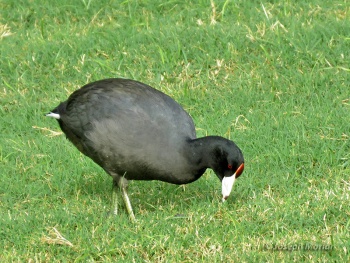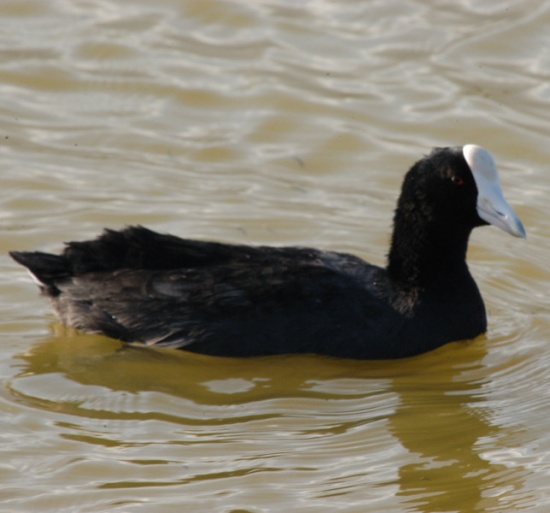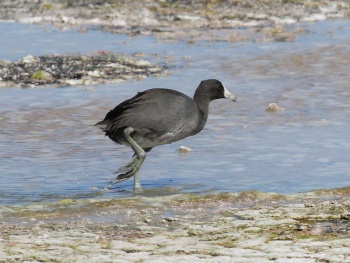- Fulica alai
Identification

Photo © by Joseph Morlan
Hokuala Golf Course (formerly Kauai Lagoons Golf Course), Kauai County, Hawaii, USA, 9 January 2020
39 cm (15¼ in)
- Dark grey
- White bill and usually frontal shield
- White undertail feathers
- Pale bluish-grey legs
Sexes similar. This species is polymorphic with a small percentage having a red rather than white frontal shield.
Similar Species
American Coot is larger and usually has a dark reddish callous at the top of the frontal shield. Eurasian Coot is also larger with a dark wedge of feathering extending laterally separating the frontal shield from the bill. Eurasian Coot also has dark undertail coverts.
Distribution
Most Hawaiian Islands
Taxonomy
- This is a monotypic species[1].
- Formerly lumped within American Coot, F. americana.
Habitat
Fresh and salt water marshes, estuaries and ponds.
Behaviour
Flight
They rarely fly, but are capable of sustained flight close to the water.
Breeding
Monogamous. They construct a floating nest in emergent vegetation; the clutch consists of 4-10 eggs.
Diet
Their mainly vegetarian diet consists of seeds and leaves of aquatic plants. The also eat insects, tadpoles, and small fish.
Vocalisation
Chicken-like “keck-keck” calls and other clucks and croaks similar to calls of American Coot.
Movements
Poorly known. Mostly resident but occasionally moves between islands.
References
- Clements, J. F., T. S. Schulenberg, M. J. Iliff, S. M. Billerman, T. A. Fredericks, B. L. Sullivan, and C. L. Wood. 2019. The eBird/Clements Checklist of Birds of the World: v2019. Downloaded from http://www.birds.cornell.edu/clementschecklist/download/
- US Fish & Wildlife Services
- Taylor, B. & Sharpe, C.J. (2020). Hawaiian Coot (Fulica alai). In: del Hoyo, J., Elliott, A., Sargatal, J., Christie, D.A. & de Juana, E. (eds.). Handbook of the Birds of the World Alive. Lynx Edicions, Barcelona. (retrieved from https://www.hbw.com/node/53696 on 28 January 2020).
- Pratt, H. D. and I. L. Brisbin Jr. (2002). Hawaiian Coot (Fulica alai), version 2.0. In The Birds of North America (A. F. Poole and F. B. Gill, Editors). Cornell Lab of Ornithology, Ithaca, NY, USA. https://doi.org/10.2173/bna.697b
- Pratt, H.D., Bruner, P., and Berrett, D.G. (1987) A Field Guide to the Birds of Hawaii and the Tropical Pacific. Princeton University Press.
- Pyle, R.L., and P. Pyle. 2017. The Birds of the Hawaiian Islands: Occurrence, History, Distribution, and Status. B.P. Bishop Museum, Honolulu, HI, U.S.A. Version 2 (1 January 2017) http://hbs.bishopmuseum.org/birds/rlp-monograph/
Recommended Citation
- BirdForum Opus contributors. (2024) Hawaiian Coot. In: BirdForum, the forum for wild birds and birding. Retrieved 28 April 2024 from https://www.birdforum.net/opus/Hawaiian_Coot





